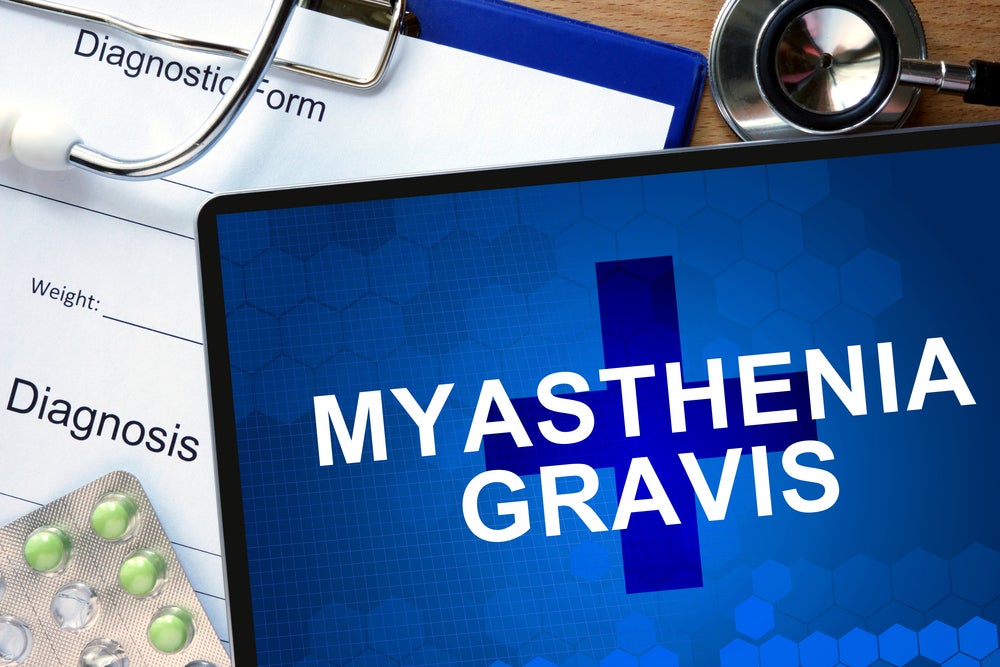The myasthenia gravis (MG) market across the seven major markets (7MM: US, France, Germany, Italy, Spain, UK, and Japan) is poised to grow at a compound annual growth rate (CAGR) of 5.6% from $6.1bn in 2024 to $10.5bn in 2034, according to GlobalData’s recently published report, Myasthenia Gravis – Opportunity Assessment and Forecast. This growth will be driven by an increase in diagnosed prevalent cases throughout the forecast period. In the US and across the 7MM, growth will be driven by an increase in diagnosed prevalence as well as the introduction of seven late-stage pipeline products: Imaavy (nipocalimab), inebilizumab, telitacicept, Descartes-08, pozelimab + cemdisiran combination therapy, CRD-1, and gefurulimab.
MG treatment regimens are determined through the classification of a patient’s clinical status and autoantibody status. On clinical presentation, there are ocular MG patients with symptoms limited to eye muscles, and generalised MG patients with symptoms involving broader muscle groups. Additionally, patients can be grouped by the presence or absence of the anti-AChR and anti-MuSK, or anti-LRP4 autoantibodies, which are often found in the serum of MG patients. There is also a seronegative MG population with no detectable antibodies, potentially involving unknown antibodies or different mechanisms. Currently, there are four main categories of treatment used in MG: corticosteroids, immunosuppressants, acetylcholinesterase inhibitors, and monoclonal antibodies. The choice of treatment is dependent on a patient’s disease stage, progression, and refractory status.
Despite differences in the clinical presentation of MG, the goal of a current pharmacotherapy is to reduce the impact of the disease on patients’ quality of life, with first-line treatments slowing disease progression and disease-modifying therapies (DMTs) aiming to halt disease progression. There are currently no curative therapies for MG. To start, most patients will be prescribed either corticosteroids or acetylcholinesterase inhibitors, with the corticosteroid prednisone and the acetylcholinesterase inhibitor pyridostigmine being the treatments most prescribed by physicians. Immunosuppressants such as azathioprine and cyclosporine are also used due to their steroid-sparing effect, as the long-term use of steroids is associated with severe side effects. Treatment with steroids, acetylcholinesterase inhibitors, and immunosuppressants is sufficient for patients with non-refractory MG.
The management of refractory MG involves more aggressive and targeted therapies than non-refractory cases, reflecting the need for advanced interventions when standard treatments fail. Treatments for refractory MG may involve the use of DMTs such as monoclonal antibodies (mAbs). There are six different DMTs available that are officially approved for the treatment of MG, including three complement 5 inhibitors and three FcRn receptor inhibitors. While these agents show high
efficacy and only mild to moderate side effects, their price range makes the treatment inaccessible to most MG patients. Furthermore, although they are highly effective, they are very specific, so they have limited efficacy in patients with differing antibody statuses. For example, AChR-positive patients are usually prescribed FcRn inhibitors such as Argenx SE’s Vyvgart (efgartigimod alfa) or complement 5 inhibitors such as Alexion Pharmaceuticals’ Soliris (eculizumab), as both classes have limited efficacy in MuSK patients. Of the seven late-stage pipeline agents, six of them—Imaavy, inebilizumab, telitacicept, Descartes-08, pozelimab + cemdisiran combination therapy, and CRD-1—are anticipated to be used across patients with multiple antibody statuses. This signals a shift in the treatment paradigm towards more targeted therapies. As a result, the treatment landscape for DMTs is expected to become highly competitive. Despite this, there is still a significant unmet need for effective treatments targeting the seronegative MG population. There is one treatment in the late-stage pipeline, the pozelimab + cemdisiran combination therapy, which is anticipated to be used in the seronegative MG population, and this is expected to gain significant market share in this patient population.
GlobalData forecasts that the late-stage pipeline products could drive combined sales of approximately $3.0 billion by 2034 in the 7MM. GlobalData also anticipates that the most promising pipeline product will be the combination therapy of Regeneron Pharmaceuticals’ pozelimab and Alnylam Pharmaceuticals’ cemdisiran, which is indicated for the treatment of AChR antibody+ generalised and seronegative/LRP4 antibody+ generalised MG. It has the potential to see strong uptake due to its position as a DMT for seronegative MG, a patient segment with limited effective treatments.

US Tariffs are shifting - will you react or anticipate?
Don’t let policy changes catch you off guard. Stay proactive with real-time data and expert analysis.
By GlobalDataWhile the overall MG market is expected to experience growth until 2034, continued generic erosion and the entry of biosimilars will be an important barrier to growth. Generic erosion and the entry of biosimilars are expected to be particularly significant in the US MG market. DMTs that will be affected by patent expiries and subsequent sales erosion by biosimilar products include Argenx SE’s Vyvgart (efgartigimod alfa) and Vyvgart Hytrulo (efgartigimod alfa + hyaluronidase [human recombinant]), Alexion Pharmaceuticals’ Soliris (eculizumab) and Ultomiris (ravulizumab LA), and UCB Pharma Ltd.’s Zilbrysq (zilucoplan). All of these are high-grossing DMTs that generated an estimated combined $5.0bn in sales across the 7MM in 2024.
Although the impending entry of numerous biosimilar products will act as a major barrier to growth, late-stage pipeline products have the potential to generate significant growth in the MG market. This, coupled with the increase in diagnosed prevalent cases, will act as the main drivers of growth across the 7MM.






